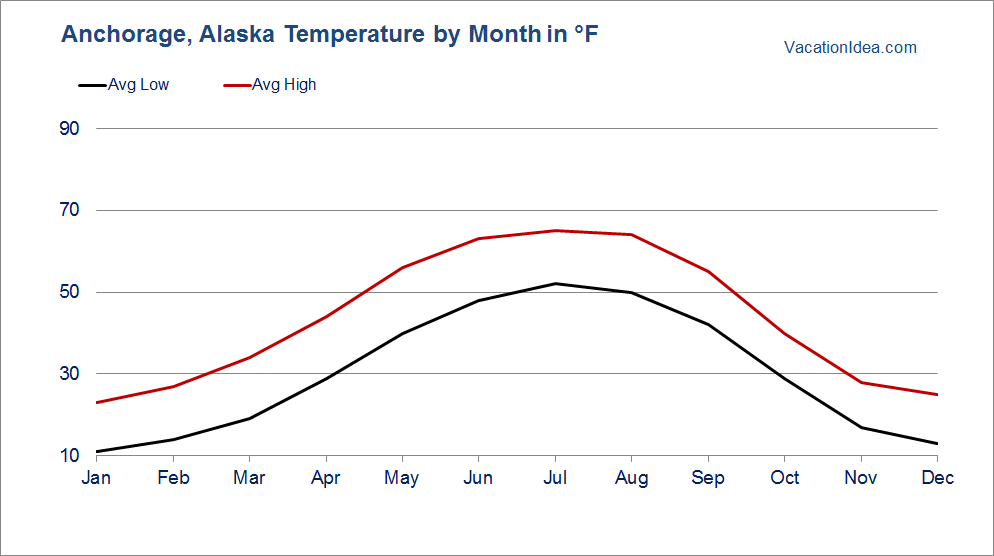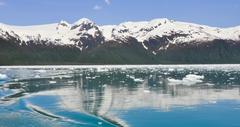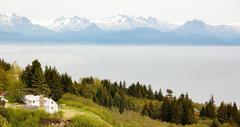Anchorage is the summer - this is the time when you’ll have the nicest weather and the warmest temperatures, maybe not warm enough to go swimming, but pleasant weather for sightseeing. There are nearly 500 flower beds in bloom in Anchorage during the summer.
Glacier cruises are popular during the summer months. The spring and fall are a bit colder, but there are few crowds and room rates are lower. Spring is the whale watching season and begins as early as April 1. Winter is definitely cold in Anchorage, but for outdoor winter enthusiasts, opportunities abound and visitors will be treated to the Northern Lights.
January is the coldest month of the year in Anchorage with an average high temperature of 23°F (-5°C). Average low temperatures sink to a frigid 11°F (-12°C). Though it isn’t the month with the highest amount of snowfall, freezing temperatures retain a lot of the snow from December, making January a fantastic month of winter sports in general.
Anchorage Weather in February: The temperatures remain quite cold in February as the winter months continue in Anchorage. High temperatures will peak at an average of 27°F (-3°C) but low temperatures can sink to a 14°F (-10°C) average.
In March, the temperature increases to an average high temperature of 34°F (1°C). Meanwhile, the average low temperature climbs to 19°F (-7°C). March is the last of the peak months for skiing and snow boarding.
April sees the least amount of snowfall out of the year in Anchorage at 4 inches (10 cm). Additionally, April also has the lowest precipitation rate annually with just under half an inch (12 mm) on average. 44°F (7°C) is the average high temperature to be expected while 29°F (-2°C) is the average low temperature. It’s important to note that Alaska doesn’t have a spring season. Rather, there is a breakup season wherein the ice begins to melt and slush.

In May, the continues a steady increase with an average high temperature of 56°F (13°C). All snowfall completely stops in May resulting in the melting of bodies of water and the slushing of snow. As such, winter sports and activities come to an end in May and the salmon season begins.
Anchorage Weather in June: The breakup season continues in June and the temperature continues to rise. The average high temperature reaches 63°F (17°C) this month with Anchorage also experiencing the most amount of sunshine in the entire year - 288 hours. The low temperature will peak at 48°F (9°C).
July is the hottest month of the year with an average high temperature of 65°F (19°C). Low temperature in July is at an average of 52°F (11°C). The mild temperatures this month make it the best time of the year to enjoy outdoor activities like hiking and trekking.
In August, Anchorage experience the highest precipitation rate of the year with 3 inches (83 mm) of average rainfall. Temperatures decrease slightly with the average high and average low temperatures ranging between 64°F (18°C) and 50°F (10°C).
Anchorage Weather in September: The last of the breakup months is Anchorage is September. During this month, the temperature continues its downward trend to an average high temperature of 55°F (13°C). Low temperature is 42°F (6°C).
In October, the winter season starts again with the temperature levels dropping quickly to an average high of 40°F (5°C). The average low temperature is a freezing 29°F (-2°C). Snow starts to blanket the city with 8 inches (20 cm) to be expected.
November sees temperatures dropping even further as winter picks up. Snowfall increases to 13 inches (33 cm) while the average low temperatures sink to 17°F (-9°C). High temperatures average at 28°F (-2°C).
Anchorage Weather in December: The month of December receives the highest amount of snowfall out of the entire year with a whopping average of 17 inches (43 cm). Additionally, December receives the least amount of sunshine in the year with just 49 hours of light to be expected. The average high temperature is 25°F (-4°C), while the average low temperature is 13°F (-10°C).
Arguably the best time to visit Alaska is during the summer months of June through August. These months also receive the most sunshine out of the year and bring warmer temperatures making outdoor activities more enjoyable. For hiking or trekking trips to Denali National Park, the best time to come is during July. To enjoy the best of Alaska’s salmon fishing trips and to catch the salmon run, it’s ideal to plan a visit between late May until August. Skiing, snow boarding and other winter sports are best from December through March. Verified Resource: National Weather Service





